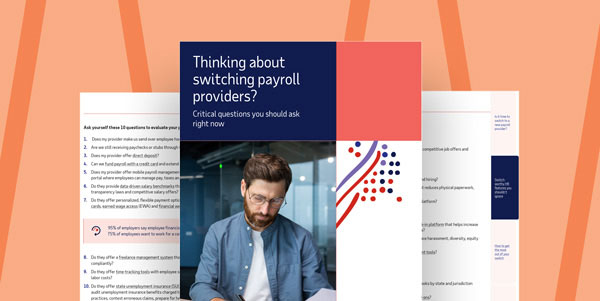Want more exclusive business insights like this delivered to your inbox?Subscribe now
Payroll compliance means adhering to all federal, state and local regulations that govern how employees are paid. Employers that violate any of these laws may face penalties that could negatively affect their bottom line or even put them out of business. But by learning how to navigate payroll compliance, they can help avoid tax trouble and maintain positive workforce morale. After all, the livelihood of employees and their families depends greatly on receiving secure, accurate and timely payment for their work.

Payroll compliance guide: 2024
Employers may want to be aware of the following changes for the 2024 tax year:
- Social Security wage base increased to $168,600
- Health flexible spending arrangement (FSA) contribution limit increased to $3,200
- Pre-tax contribution level for 401(k) increased to $23,000
- FICA threshold for household employees increased to $2,700
Payroll laws and regulations
The laws that govern payroll are extensive. In addition to the various state and local regulations, some of the federal legislation that employers should be aware of includes:
- Fair Labor Standards Act (FLSA)
The FLSA sets the national minimum wage and overtime rates, as well as payroll recordkeeping requirements and child labor laws. - Federal Insurance Contributions Acts (FICA)
FICA is a payroll tax that funds Social Security and Medicare. - Federal Unemployment Tax Act (FUTA)
Another type of payroll tax, FUTA, offers temporary income assistance for workers who have lost their job through no fault of their own. - Equal Pay Act (EPA)
Designed to prevent wage discrimination based on sex, the EPA requires employers to provide equal pay to men and women who perform similar jobs in the same workplace. - Davis-Bacon Act
The Davis-Bacon Act requires businesses engaged in public works projects to compensate laborers and mechanics with prevailing wages.
Payroll tax compliance
At its most basic level, complying with payroll regulations means:
- Calculating wages, including overtime, accurately
- Withholding the correct amount of payroll taxes from the wages subject to each applicable payroll tax (e.g., Social Security taxes)
- Timely depositing the corresponding tax liabilities with the appropriate federal, state and local tax agencies
- Filing payroll tax returns with each of those jurisdictions
More specific guidelines pertain to the following aspects of payroll:
FICA compliance
Between employee and employer contributions, FICA taxes total 15.3%. Employees pay 1.45% of their gross income to Medicare and another 6.2% to Social Security. Employers must match both, so their tax responsibility is 7.65%. Note that there is a wage-based contribution limit for Social Security, but not Medicare.
FUTA compliance
Unemployment is funded by employers, not employees. The law requires employers to pay 6% of the FUTA wage base, which is the first $7,000 of an employee’s annual earnings. If a business is also subject to state unemployment tax, it may be eligible for a credit of up to 5.4%, which lowers the FUTA tax rate to 0.6%.
Federal income tax compliance
The federal income tax rate currently ranges from the 10% marginal rate to 37% across seven different tax brackets. To determine how much to withhold from employee wages, employers need to refer to each individual’s Form W-4 and follow the instructions in IRS Publication 15-T, Federal Income Tax Withholding.
FLSA compliance
Employees who are non-exempt from FLSA must be paid the federal minimum wage, which is $7.25 per hour, and are entitled to overtime. The overtime rate is no less than one-and-a-half times their regular pay for each hour over 40 in a workweek. Employers who operate in a state with a higher minimum wage or overtime rate must abide by the state regulations.
Payroll compliance: state requirements
Payroll compliance is difficult enough in one state, but as businesses expand into other jurisdictions, the complexity only increases. Some states follow the federal income tax code, others charge a fixed rate or create their own tax brackets, and a few charge no income tax at all. How and when state income taxes are filed and the penalties for noncompliance may also vary from state to state.
In addition to income tax, states have different unemployment tax rates, minimum wage requirements, and disability insurance costs. Check out ADP’s fast wage and tax facts resource to see the specific guidelines in all 50 states and how they compare to the federal government.
International payroll rules
A one-size-fits-all approach to payroll won't work for employers that conduct business overseas. The global marketplace is complex and highly regulated, and even if the organization’s headquarters is based in the United States, it must abide by the local, state and country laws where its employees are working. Here are some of the international regulations that may affect how employers process payroll:
- European Union Working Time Directive (WTD)
Designed to protect employee health and safety, the WTD limits the number of hours individuals can work per week, including overtime. It also sets minimum standards for break periods and paid leave. Member nations can make amendments, so the way in which the WTD is enforced in one country might not be the same in another. - Labor Law of the People’s Republic of China
In addition to regulating how many hours employees can work per day and per week, the Labor Law provides guidelines on employment contracts, wages, labor disputes, working conditions, welfare and overtime. - Wages Protection System of the United Arab Emirates (UAE)
The WPS requires businesses to register with the Ministry of Human Resources and Emiratisation and pay employees through an approved financial institution by established deadlines. If employers don’t register or make the payments on time, they can be denied work permits. - UK Employment Rights Act
This law provides guidance for employment contracts, reasonable dismissal notices, unfair dismissal, parental leave and redundancy. - Labor Standards Act of Japan
Since it’s passage in 1947, Japan’s Labor Standards Act has been amended numerous times and covers minimum wage, working hours and overtime, and annual leave, among other employment issues. - German Act on Part-Time Work and Fixed-Term Contracts
Guidelines for increasing or reducing work hours during fixed-term employment are covered in this legislation.
The cost of non-compliance
Failing to pay employees on time, filing payroll taxes incorrectly or late, and keeping sloppy and incomplete payroll records can be very detrimental to businesses. Some of the consequences employers may experience by not complying with payroll laws and regulations include:
- Back payment of missing pay
- Audits and fines from government agencies
- Penalty and interest
- Legal expenses
- Decreased employee morale
- Loss of irreplaceable data
Common payroll compliance mistakes
Anyone can enter information incorrectly or misplace a form. Add the fact that payroll regulations and taxes are constantly evolving, and it’s easy to see how payroll mistakes happen. Some of the most common are:
Misclassifying exemptions
Employees can claim that they are exempt from federal income tax on Form W-4 if they either had no tax liability in the previous year or expect none in the current year. Individuals who sometimes fall into this category are students, part-time or seasonal workers, and those 65 and older or blind. The IRS may ask to review the exemption request, and if they determine that it’s not valid, they will send the employer and the employee a lock-in letter. This document will dictate the employee’s income tax withholding rate, which employers must abide by or their business may be held liable for the back taxes.
Misclassifying employees and independent contractors
Worker classification is important because it determines who has taxes withheld from their pay and who doesn’t. If an individual directs the work being done and how it’s done, but the employer controls the final result of that work, then that person is generally an independent contractor. These types of workers pay self-employment tax, so employers don’t deduct taxes from their earnings. On the other hand, if someone has no control of their work – either what is done or how it’s done – that person is typically an employee and the employer would withhold the required payroll taxes.
The distinction between independent contractors and employees is easily blurred and mistakes are costly. Businesses can face fines and levies for misclassifications and may owe any back taxes or unpaid overtime wages that occurred. If in doubt about a worker’s status, employers should submit Form SS-8 to the IRS.
Equal Pay Act non-compliance
The Equal Pay Act states that men and women in the same workplace must receive equal pay for equal work. All forms of compensation are covered, including salaries, bonuses, overtime pay, stock options, life insurance and profit-sharing. Employees who think their employer is not complying with this law can file complaints with the Equal Opportunity Commission and bring civil lawsuits against the business.
There are, however, measures that can help prevent gender pay gaps, such as:
- Auditing wage rates annually
- Using industry income averages as benchmarks
- Documenting all pay decisions
- Making compensation visible organization-wide
- Banning salary negotiations
Workers’ compensation errors
Insurance premiums for workers’ compensation are based in part on employee classifications, total payroll for each class, and in some cases, total hours worked. Most states require insurance carriers to conduct an annual audit of employers’ policies and if any of their payroll records are incorrect, they may owe additional money towards their premium. These audits usually take place between 30 and 45 days after the policy expires for a given year. Conducting an internal audit before the insurance company performs theirs can help employers address any payroll, timekeeping or job classification errors that might affect their premium.
How to avoid payroll compliance mistakes
Many compliance mistakes can be avoided by keeping payroll records in order. Make sure that new hires turn in all the necessary documents and review them carefully for inverted numbers, incomplete or missing data fields, and incorrect dates. Afterward, file the paperwork so it can be easily accessed by both the HR and payroll departments.
Use payroll software
Even with meticulous recordkeeping, paper forms can go missing and manual data entry increases the chance of mistakes. A better solution is payroll software. It offers a host of compliance-related benefits, such as:
- Automation
Automated payments to employees and government agencies helps ensure deadlines are met. - Security
Cutting-edge security protects the sensitive information of employees and the business. - Accuracy
Payroll service providers stay current with ever-changing employment and tax regulations. - Integration
Integrating payroll software with time and attendance and benefits administration can save employers from entering the same information repeatedly and reduce errors. - Accessibility
Documents necessary for payroll, like Form W-2 and new hire reports, may be readily available. - Global capabilities
Payroll service providers that have global systems of record are able to provide international employers with a comprehensive view of their entire workforce.
Make a payroll compliance checklist
The following checklist can help ensure that employers have the right data for payroll compliance when onboarding employees. Small business owners can download our Payroll Checklist for a deeper dive.
- Classify new hire appropriately (employee or independent contractor?)
- Visually inspect all onboarding paperwork for missing information or details that don’t match identification documents
- Carefully enter all the data into HR and payroll software
- Double-check personal information, wages, tax codes, enrolled benefits, working hours, banking information and any other relevant details
- Update files as needed for pay increases, name changes, benefit alterations, leave of absence, etc.
Frequently asked questions about payroll compliance
What is payroll compliance?
Payroll compliance refers to the steps every employer must take to abide by the tax regulations, wage and hour rules and other applicable requirements related to payroll. These steps include maintaining the proper forms for each employee, withholding and filing taxes, using the correct tax codes for the business, collecting and filing garnishments, observing federal and state overtime rules, and more.
What are the laws governing payroll?
There are many laws governing payroll at the federal, state, local and international levels. Some of them include:
- Fair Labor Standards Act (FLSA)
- Federal Insurance Contributions Acts (FICA)
- Federal Unemployment Tax Act (FUTA)
- Davis-Bacon Act
- Equal Pay Act
- UK Employment Rights Act
- Japan Labor Standards Act
- German Act on Part-Time Work and Fixed-Term Contracts
Why is payroll compliance legislation important?
Complying with payroll regulations is a significant employer responsibility because it:
- Ensures employees are compensated correctly for their work
- Funds social service programs, like Medicare and unemployment
- Helps reduce the risk of penalties and lawsuits
- Improves workforce morale
How do you ensure accuracy in payroll?
- Classify workers correctly
- Keep meticulous employee and payroll records
- Stay informed of the latest payroll regulations
- Automate payroll with software programs
- Integrate payroll with timekeeping and benefits administration
- Audit payroll processes regularly
How does ADP payroll work?
ADP’s payroll software helps eliminate compliance mistakes by automatically calculating and withholding the right amount of taxes from employee wages and then depositing those funds with the applicable federal, state and local government agencies at the proper time.
What is ADP SmartCompliance?
ADP SmartCompliance® is a technology and service product designed to help midsized and large businesses manage complex, employment-related compliance requirements, including employment taxes, Form W-2 management, wage payments, wage garnishments, tax credits, employment verification and unemployment claims. The individual modules are customizable and easily scale with an organization as it grows.
This guide is intended to be used as a starting point in analyzing an employer’s payroll obligations and is not a comprehensive resource of requirements. It offers practical information concerning the subject matter and is provided with the understanding that ADP is not rendering legal or tax advice or other professional services. Tax figures provided are as of the 2021 tax year.





